Highlights from home
6 years ago
A Blog about Living and Working in Guangzhou, China.
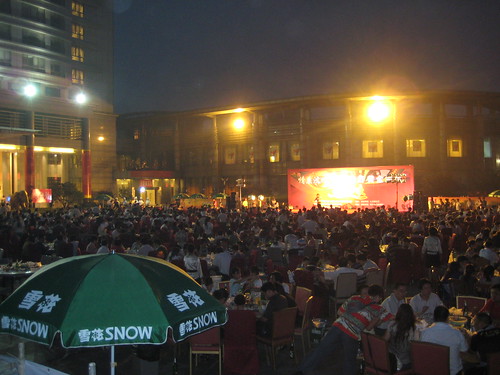
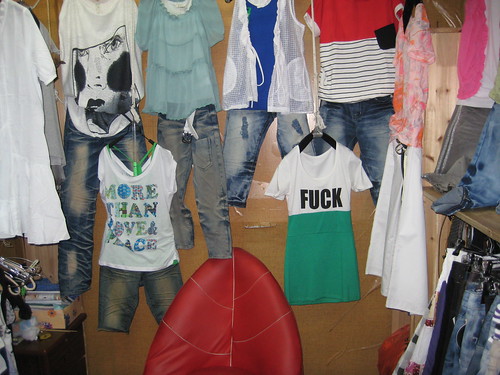

 Finally near the end of the book Zhao talks about how he believes that the only way for China to continue forward both with economy and politics is to adopt a more western style of government including a real multiparty democracy. He writes here near the end of the book, "I once believed that people were the masters if their own affairs not in the parliamentary democracies of the developed nations in the West, but only in the Soviet and socialist nations' systems with a people's congress, making the latter system more advanced and a better-realized form of democracy. This, in fact, is not the case. The democratic systems of out socialist nations are all just superficial; they are not systems in which the people are in charge, but rather are ruled by a few or even a single person." It may not be anything earth shattering to say the communist countries aren't really for the people but it's not every day that a former General Secretary of the Chinese Communist Party says it. The last really interesting thing is the black and white picture I have in this post. The figure in the center with the bullhorn is Zhao here appearing in Tienanmen Square, after he was essentially forced out of power and only hours before the tanks would come rolling in, pleading with the students to leave. He said that while it was too late for him and too late for the protest that they were young and should still leave while they could. Standing just to the right of him and looking directly into the camera is Wen Jiabao the current Primer of China who worked under Zhao at the time. What is really clear from the book is that the legacy of that fateful day changed forever the course of Chinese history.
Finally near the end of the book Zhao talks about how he believes that the only way for China to continue forward both with economy and politics is to adopt a more western style of government including a real multiparty democracy. He writes here near the end of the book, "I once believed that people were the masters if their own affairs not in the parliamentary democracies of the developed nations in the West, but only in the Soviet and socialist nations' systems with a people's congress, making the latter system more advanced and a better-realized form of democracy. This, in fact, is not the case. The democratic systems of out socialist nations are all just superficial; they are not systems in which the people are in charge, but rather are ruled by a few or even a single person." It may not be anything earth shattering to say the communist countries aren't really for the people but it's not every day that a former General Secretary of the Chinese Communist Party says it. The last really interesting thing is the black and white picture I have in this post. The figure in the center with the bullhorn is Zhao here appearing in Tienanmen Square, after he was essentially forced out of power and only hours before the tanks would come rolling in, pleading with the students to leave. He said that while it was too late for him and too late for the protest that they were young and should still leave while they could. Standing just to the right of him and looking directly into the camera is Wen Jiabao the current Primer of China who worked under Zhao at the time. What is really clear from the book is that the legacy of that fateful day changed forever the course of Chinese history.

 When I got home I took off the hook and weight system they had put on and just attached a basic hook and some weight. Now for one thing I don't know much about fishing, and for another I don't know anything about tying knots so that I'm not sure the thing I came up with would ever have been able to catch a fish. Of course that wasn't much of a problem since there is no way there were any fish living in the water I was fishing in. It's not just the pollution, fish can live in some pretty murky water it's that I don't think the canal I was in actually connected to much of anything besides some pipes. But the point wasn't to catch fish it was just to fish, so one sunny afternoon Dave and I headed out to the canal to try our luck. Just as I was hoping there were a lot of odd looks and some concerned questions from the people passing us by. Catch and release must not be a Chinese thing since people were all relived when I told them I wasn't planning on eating anything I caught. The person who spent the most time watching us was a worker or gardener who was taking a break. He was wearing the perfect fishing hat but I wasn't quite sure how to ask to borrow it. Eventually I realized though the biggest flaw in my plan, I don't like fishing. I got bored pretty quick and after there weren't many students left I gave up, though I did catch a nice piece of some weed. Now the fishing pole sit mounted on my wall since there's never going to be a fish there.
When I got home I took off the hook and weight system they had put on and just attached a basic hook and some weight. Now for one thing I don't know much about fishing, and for another I don't know anything about tying knots so that I'm not sure the thing I came up with would ever have been able to catch a fish. Of course that wasn't much of a problem since there is no way there were any fish living in the water I was fishing in. It's not just the pollution, fish can live in some pretty murky water it's that I don't think the canal I was in actually connected to much of anything besides some pipes. But the point wasn't to catch fish it was just to fish, so one sunny afternoon Dave and I headed out to the canal to try our luck. Just as I was hoping there were a lot of odd looks and some concerned questions from the people passing us by. Catch and release must not be a Chinese thing since people were all relived when I told them I wasn't planning on eating anything I caught. The person who spent the most time watching us was a worker or gardener who was taking a break. He was wearing the perfect fishing hat but I wasn't quite sure how to ask to borrow it. Eventually I realized though the biggest flaw in my plan, I don't like fishing. I got bored pretty quick and after there weren't many students left I gave up, though I did catch a nice piece of some weed. Now the fishing pole sit mounted on my wall since there's never going to be a fish there.

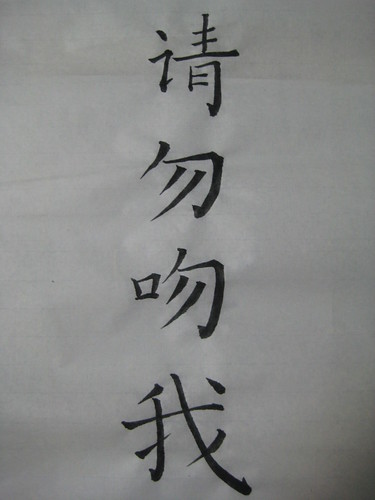
 After me and Ken got back form our respective trips to and near the DMZ we wanted to head over to this big tower that looks down over Seoul. To get there we took a taxi to a cable car that brought us up and down. I like cable cars fine but I can't help thinking every time I see one that this is just another missed opportunity for a zip line. At the top of the cable car before the tower there were some weird art displays including these wire outlines of people that were suspended well above the ground like superman flying by and then illuminated by lights. The tower itself had a nice panoramic view of Seoul which was made all the nicer by the neon lights of a clear night. Seoul is a huge city much bigger than it looks from the ground since it is more spread out than most cities of its size. I could see avenues and neighborhoods running in all directions and even a few of the other cities which make up the greater Seoul area. It's still pretty amazing to me that a city as big as Seoul can be a clean or have so little congestion. We hung around there for quite some time as the tower was a nice place to sit and there were all these fun little signs saying how far it was to various points, which I guess is a tired mechanic but I still like it.
After me and Ken got back form our respective trips to and near the DMZ we wanted to head over to this big tower that looks down over Seoul. To get there we took a taxi to a cable car that brought us up and down. I like cable cars fine but I can't help thinking every time I see one that this is just another missed opportunity for a zip line. At the top of the cable car before the tower there were some weird art displays including these wire outlines of people that were suspended well above the ground like superman flying by and then illuminated by lights. The tower itself had a nice panoramic view of Seoul which was made all the nicer by the neon lights of a clear night. Seoul is a huge city much bigger than it looks from the ground since it is more spread out than most cities of its size. I could see avenues and neighborhoods running in all directions and even a few of the other cities which make up the greater Seoul area. It's still pretty amazing to me that a city as big as Seoul can be a clean or have so little congestion. We hung around there for quite some time as the tower was a nice place to sit and there were all these fun little signs saying how far it was to various points, which I guess is a tired mechanic but I still like it.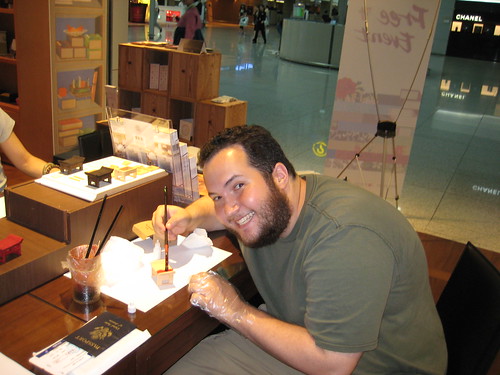 The next morning before the flight we had some time so we headed over to what one map said was a really big fish market. It took some finding but when we found it it certainly did not disappoint. To call it a fish market is actually somewhat wrong since so many of the best things there were crabs, shrimp, monstrous squid and octopus and all manor of things that live in the sea. I've never seen any octopus as big as some of the ones that people were tossing around. The place also seemed to stretch on for a mile with just store after store. It was I think divided into some sections but it certainly wasn't too clear to someone just wandering in. I wonder exactly how many normal people just go there on a day to day basis since with the volume they have on display they must have to sell a ton before it all goes bad. we walked around for a while and I'm not sure all the people who were working really appreciated having us there but it was just too interesting not to go. After that we still had a lot of time before the plane so instead of taking a bus out to the airport we took a series of subways which got us there pretty fast. You couldn't see to much but I respect any airport which you can take the subway to.
The next morning before the flight we had some time so we headed over to what one map said was a really big fish market. It took some finding but when we found it it certainly did not disappoint. To call it a fish market is actually somewhat wrong since so many of the best things there were crabs, shrimp, monstrous squid and octopus and all manor of things that live in the sea. I've never seen any octopus as big as some of the ones that people were tossing around. The place also seemed to stretch on for a mile with just store after store. It was I think divided into some sections but it certainly wasn't too clear to someone just wandering in. I wonder exactly how many normal people just go there on a day to day basis since with the volume they have on display they must have to sell a ton before it all goes bad. we walked around for a while and I'm not sure all the people who were working really appreciated having us there but it was just too interesting not to go. After that we still had a lot of time before the plane so instead of taking a bus out to the airport we took a series of subways which got us there pretty fast. You couldn't see to much but I respect any airport which you can take the subway to. The airport itself had been voted best airport in the world or so the endless parade of banners kept telling us. Actually I like the Shanghai airport better since the Seoul airport seems to intent on selling you stuff that it's actually hard to find where you're supposed to check in. After we checked in though they had this cool little place where we could make free handicrafts. We were given a little box with pieces to a dollhouse sized desk and some glue and paint. I didn't take too much care with mine but Ken was all about his, though he left it on the plane by accident. The girl who was telling us what to do actually took part of mine apart and redid it because I was apparently gluing the table together in a non-proscribed way.After making our little tables and going to the flight we had one more surprise ahead as when we landed in Shanghai due to the pig flu scare they had people in moon suits go through the plane and check everyone's temperature. It actually took a really long time since if they wern't sure about someone they had more tests to run. A few people got pulled aside and I really wanted to be one of them. I heard about how nice the places they were putting people up were and I had nothing to do for about two weeks before I was going back to the US so I had no problem with getting put up in a nice Shanghai hotel by the government. Alas it wasn't to be and my damn lack of a fever just had me sent back to Changzhou on the train.
The airport itself had been voted best airport in the world or so the endless parade of banners kept telling us. Actually I like the Shanghai airport better since the Seoul airport seems to intent on selling you stuff that it's actually hard to find where you're supposed to check in. After we checked in though they had this cool little place where we could make free handicrafts. We were given a little box with pieces to a dollhouse sized desk and some glue and paint. I didn't take too much care with mine but Ken was all about his, though he left it on the plane by accident. The girl who was telling us what to do actually took part of mine apart and redid it because I was apparently gluing the table together in a non-proscribed way.After making our little tables and going to the flight we had one more surprise ahead as when we landed in Shanghai due to the pig flu scare they had people in moon suits go through the plane and check everyone's temperature. It actually took a really long time since if they wern't sure about someone they had more tests to run. A few people got pulled aside and I really wanted to be one of them. I heard about how nice the places they were putting people up were and I had nothing to do for about two weeks before I was going back to the US so I had no problem with getting put up in a nice Shanghai hotel by the government. Alas it wasn't to be and my damn lack of a fever just had me sent back to Changzhou on the train.
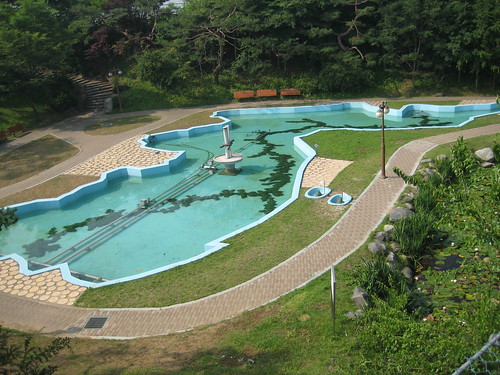
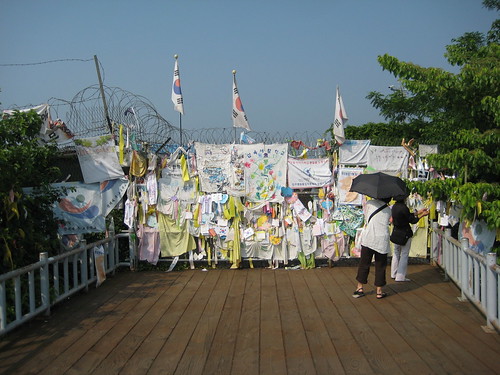 Though no one really travel between the Koreas any more right after the war ended a number of families were split apart, a legacy which remains to this day. There is also a train bridge that I don't believe actually goes anywhere but is one of the many things they seem to build on the theory that one day it will be useful. The most interesting thing was a big pool shaped like the Korean peninsula, which had a fountain that wasn't on while I was there. Next we went to a place up on a hill that overlooked the DMZ. There were those big tourist telescopes that allowed you to look down over the DMZ and even into North Korea. In the DMZ you could see two model villages where apparently the farmers had to be guarded by soldiers while they planted crops. The North Korean one is apparently empty just housing a huge sound system so that they can broadcast propaganda messages at the other village. Both villages have gigantic flag poles with the North Korean one being a little bigger as apparently the South Koreans figured that they had better stuff to do at some point. The area is actually noted for its lack of development due to the high tension. The whole DMZ has become something of a sanctuary for rare and endangered birds since so few people live or go into it.
Though no one really travel between the Koreas any more right after the war ended a number of families were split apart, a legacy which remains to this day. There is also a train bridge that I don't believe actually goes anywhere but is one of the many things they seem to build on the theory that one day it will be useful. The most interesting thing was a big pool shaped like the Korean peninsula, which had a fountain that wasn't on while I was there. Next we went to a place up on a hill that overlooked the DMZ. There were those big tourist telescopes that allowed you to look down over the DMZ and even into North Korea. In the DMZ you could see two model villages where apparently the farmers had to be guarded by soldiers while they planted crops. The North Korean one is apparently empty just housing a huge sound system so that they can broadcast propaganda messages at the other village. Both villages have gigantic flag poles with the North Korean one being a little bigger as apparently the South Koreans figured that they had better stuff to do at some point. The area is actually noted for its lack of development due to the high tension. The whole DMZ has become something of a sanctuary for rare and endangered birds since so few people live or go into it. I could also see down into the Kaesong Industrial Park a industrial area where South Korean companies could use North Korean labor. The park was actually having trouble just as I got to Korea and the North Korean government was demanding higher wages, the wages were paid directly to the North Korean government who supposedly gave them to the workers. The park was actually a lot bigger than I thought as I saw some rail and a bunch of machinery suited for heavy industry. The whole thing was basically the brain child of the founder of Hyundai who was originally from North Korea, though before the war. According to legend he stole a cow from his family's village and used the money to start the company. Years later besides starting the Industrial Park he also donated 1001 cows back to North Korea as a form of food aid/publicity stunt. While you could look over into North Korea you weren't allowed to take any pictures over the side. They had a designated picture taking zone from which I could see exactly nothing worth taking a picture of. Next we headed to the famous third tunnel. After the war despite high tension on the DMZ North Korea tried several times to build tunnels under the DMZ for god only know what purpose.
I could also see down into the Kaesong Industrial Park a industrial area where South Korean companies could use North Korean labor. The park was actually having trouble just as I got to Korea and the North Korean government was demanding higher wages, the wages were paid directly to the North Korean government who supposedly gave them to the workers. The park was actually a lot bigger than I thought as I saw some rail and a bunch of machinery suited for heavy industry. The whole thing was basically the brain child of the founder of Hyundai who was originally from North Korea, though before the war. According to legend he stole a cow from his family's village and used the money to start the company. Years later besides starting the Industrial Park he also donated 1001 cows back to North Korea as a form of food aid/publicity stunt. While you could look over into North Korea you weren't allowed to take any pictures over the side. They had a designated picture taking zone from which I could see exactly nothing worth taking a picture of. Next we headed to the famous third tunnel. After the war despite high tension on the DMZ North Korea tried several times to build tunnels under the DMZ for god only know what purpose. Of these tunnels the most recent or third tunnel is probably the most famous as it actually made it all the way across the DMZ before they stopped it. Apparently they only even knew about it thanks to a defecting engineer. The South Korean built an intercepting tunnel and stopped the North Koreans sending them back. In a despite and just plain odd attempt to hide what they had been doing the North Koreans painted the entire tunnel black and claimed they had been looking for coal. The South Korean eventually sealed off the tunnel where it went across the border but widened the entrance they had built and turned it into a tourist attraction. The sight became so popular that at one point North Korea demanded some of the money for it reasoning that they had built the tunnel after all, they were let's say rebuffed. The entrance to the tunnel was a long sloping walk way that was steep enough and long enough that it was like walking up a 30 story building. It never looked like that much while I was in it but going up was extremely tiring. Since it was deep enough underground it was close to the earth's core temperature which is pretty cool. They made us wear hard hats which was a good thing as I bumped my head into the ceiling pretty hard a couple of times.
Of these tunnels the most recent or third tunnel is probably the most famous as it actually made it all the way across the DMZ before they stopped it. Apparently they only even knew about it thanks to a defecting engineer. The South Korean built an intercepting tunnel and stopped the North Koreans sending them back. In a despite and just plain odd attempt to hide what they had been doing the North Koreans painted the entire tunnel black and claimed they had been looking for coal. The South Korean eventually sealed off the tunnel where it went across the border but widened the entrance they had built and turned it into a tourist attraction. The sight became so popular that at one point North Korea demanded some of the money for it reasoning that they had built the tunnel after all, they were let's say rebuffed. The entrance to the tunnel was a long sloping walk way that was steep enough and long enough that it was like walking up a 30 story building. It never looked like that much while I was in it but going up was extremely tiring. Since it was deep enough underground it was close to the earth's core temperature which is pretty cool. They made us wear hard hats which was a good thing as I bumped my head into the ceiling pretty hard a couple of times. In the tunnel I was actually able to get within 100 meters of the boarder, the point at which the South Koreans had begun to put up walls and what not. Despite it being cold and wet underneath it was incredibly cool and you could actually see the paint and coal dust they had brought in to disguise the tunnel. After I came out of the tunnel I went through a little museum that described the history of the area. The last stop before the lunch was at a railway station that was built just outside the DMZ with the idea that someday it would be the jumping off point for when normal traffic started between North and South Korea. There was even an odd painting of a train heroically going between the Koreas. The whole thing looked like a big working train station but there was only one train a day from Seoul and that was only for tourists. After that we went to this place for lunch which was included in the price of the trip. After lunch our group joined up with a few other groups. I was apparently the last one on the bus after I went to the bathroom even though I was still 15 minutes early.
In the tunnel I was actually able to get within 100 meters of the boarder, the point at which the South Koreans had begun to put up walls and what not. Despite it being cold and wet underneath it was incredibly cool and you could actually see the paint and coal dust they had brought in to disguise the tunnel. After I came out of the tunnel I went through a little museum that described the history of the area. The last stop before the lunch was at a railway station that was built just outside the DMZ with the idea that someday it would be the jumping off point for when normal traffic started between North and South Korea. There was even an odd painting of a train heroically going between the Koreas. The whole thing looked like a big working train station but there was only one train a day from Seoul and that was only for tourists. After that we went to this place for lunch which was included in the price of the trip. After lunch our group joined up with a few other groups. I was apparently the last one on the bus after I went to the bathroom even though I was still 15 minutes early.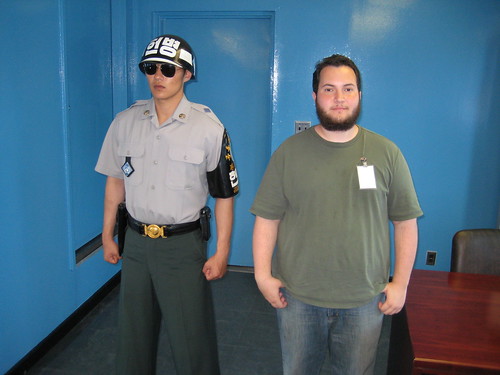 We drove off into the DMZ stopping at several points while a soldier got on the bus to take a quick look at our passports. We passed several what looked like tunnels expect they were basically just huge concrete blocks suspended above the road. The idea we were told was that if there was ever a war these would be dynamited blocking the road so that it would slow down the North Korean advance toward Seoul. We drove past roads marked with little signs to warn people that just off both sides of the road were mine fields. We came to an American base, one of the few in the DMZ since years ago they realized that while the North Koreans would launch suicide missions against American bases they more or less left the South Korean soldiers alone. In the base we watched a short history of the area and had to sign a liability waver which must be one of the few that includes a waver for "enemy activity." While the DMZ is pretty quite now that wasn't always the case. The main area we were going to was the central area and meeting point. At one time it had actually been a neutral area so North Koreans could go to the south side in that area and vise versa. But apparently while the UN forces built security check points on there side the North Koreans just built them all over the place.
We drove off into the DMZ stopping at several points while a soldier got on the bus to take a quick look at our passports. We passed several what looked like tunnels expect they were basically just huge concrete blocks suspended above the road. The idea we were told was that if there was ever a war these would be dynamited blocking the road so that it would slow down the North Korean advance toward Seoul. We drove past roads marked with little signs to warn people that just off both sides of the road were mine fields. We came to an American base, one of the few in the DMZ since years ago they realized that while the North Koreans would launch suicide missions against American bases they more or less left the South Korean soldiers alone. In the base we watched a short history of the area and had to sign a liability waver which must be one of the few that includes a waver for "enemy activity." While the DMZ is pretty quite now that wasn't always the case. The main area we were going to was the central area and meeting point. At one time it had actually been a neutral area so North Koreans could go to the south side in that area and vise versa. But apparently while the UN forces built security check points on there side the North Koreans just built them all over the place.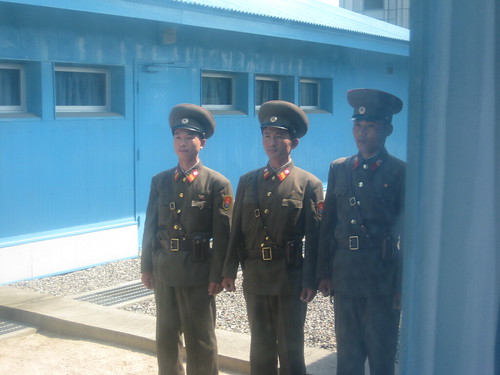 At one point there was a UN check point that was basically surrounded by North Korean ones. a tree had also blocked the view of the place so it was really cut off. An attempt had been made to cut down the tree which the North Koreans vigorously protested. When they attempted to cut down the tree a second time a North Korean soldier grabbed the axe and killed to US soldiers with it. This lead to a raising of the US's nuclear alert status and a near war and apparently even resulted in the leader of North Korea issuing an apology. The next day a team including 64 Taekwondo masters came in to cut down the tree. Years later there was a small gun fight in the DMZ after a Russian tourist defected across the line. After signing the waivers we got back on the bus and drove to the main DMZ area. We entered a big building and then were told not to take pictures and to walk in a straight line as we walked to a little blue house situated on top of the border. In the house was a conference table whose middle matched the border exactly. There were also a couple of South Korean soldiers standing perfectly still. We were allowed about 10 minutes to walk around and take pictures. Even though the house was located on the border we were free to walk around in it so I was technically in North Korea for about 5 minutes.
At one point there was a UN check point that was basically surrounded by North Korean ones. a tree had also blocked the view of the place so it was really cut off. An attempt had been made to cut down the tree which the North Koreans vigorously protested. When they attempted to cut down the tree a second time a North Korean soldier grabbed the axe and killed to US soldiers with it. This lead to a raising of the US's nuclear alert status and a near war and apparently even resulted in the leader of North Korea issuing an apology. The next day a team including 64 Taekwondo masters came in to cut down the tree. Years later there was a small gun fight in the DMZ after a Russian tourist defected across the line. After signing the waivers we got back on the bus and drove to the main DMZ area. We entered a big building and then were told not to take pictures and to walk in a straight line as we walked to a little blue house situated on top of the border. In the house was a conference table whose middle matched the border exactly. There were also a couple of South Korean soldiers standing perfectly still. We were allowed about 10 minutes to walk around and take pictures. Even though the house was located on the border we were free to walk around in it so I was technically in North Korea for about 5 minutes.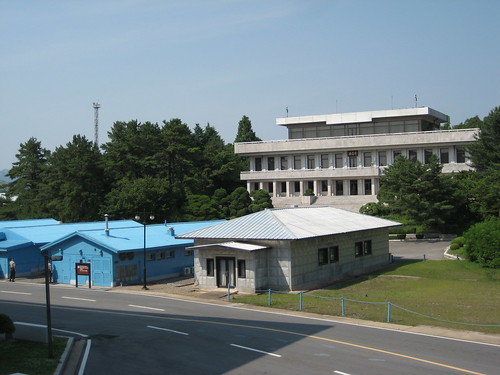 While I was inside taking pictures outside there were some actual North Korea soldiers milling around. At first I wasn't sure what exactly they were doing as they walked up to the border but it soon became clear that they were making a Christmas card, if of course North Korea had Christmas. Three of the soldiers stood at the border while another, with what looked like a ten year old camera, took a few pictures before they all left. The whole thing just seemed so bizarre. One of the most tense and dangerous borders in the world and we are all taking pictures of one another. The South Korean soldiers stood totally motionless in modified Taekwondo stances wearing glasses so they didn't make too much eye contact with the North Koreans. The North Koreans for their part seemed pretty at ease, but I suppose since they're always the ones starting shit if they aren't starting anything what's to be worried about. After milling about on top of the border we all marched single file back into the main building. Apparently some one took a picture while they were outside and they stopped and made them delete it. Actually the oddest thing they told us was that they didn't allow people in really scruffy cloths since they were worried that the North Koreans would take their picture and use it as propaganda saying look they can't afford to cloth their people. Me I hope that with my crazy beard I am now on a poster somewhere in North Korea.
While I was inside taking pictures outside there were some actual North Korea soldiers milling around. At first I wasn't sure what exactly they were doing as they walked up to the border but it soon became clear that they were making a Christmas card, if of course North Korea had Christmas. Three of the soldiers stood at the border while another, with what looked like a ten year old camera, took a few pictures before they all left. The whole thing just seemed so bizarre. One of the most tense and dangerous borders in the world and we are all taking pictures of one another. The South Korean soldiers stood totally motionless in modified Taekwondo stances wearing glasses so they didn't make too much eye contact with the North Koreans. The North Koreans for their part seemed pretty at ease, but I suppose since they're always the ones starting shit if they aren't starting anything what's to be worried about. After milling about on top of the border we all marched single file back into the main building. Apparently some one took a picture while they were outside and they stopped and made them delete it. Actually the oddest thing they told us was that they didn't allow people in really scruffy cloths since they were worried that the North Koreans would take their picture and use it as propaganda saying look they can't afford to cloth their people. Me I hope that with my crazy beard I am now on a poster somewhere in North Korea.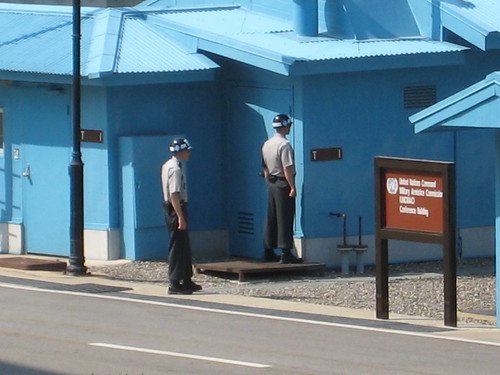 We then went outside on a little raised platform next to the building where we could look down over where we just were. They let us hang out here and take more pictures for around 15 minutes. Most of the North Koreans had gone inside so I mostly just took pictures of the buildings and the extremely tense South Korean soldiers. We got back on the bus after that and they drove us around and showed us a few more interesting things in the DMZ including the place where the axe indicant happened and a place where you could see the little stone markers that were the border stretching across the countryside. The last place we went was a gift shop on an America base where they sold little things like DMZ shot glasses and golf balls. When we finally left the DMZ they gave us the release forms back to keep. The whole thing was really interesting but quite odd as it was talked up so much as to danger but then just seemed sort of silly in many ways.
We then went outside on a little raised platform next to the building where we could look down over where we just were. They let us hang out here and take more pictures for around 15 minutes. Most of the North Koreans had gone inside so I mostly just took pictures of the buildings and the extremely tense South Korean soldiers. We got back on the bus after that and they drove us around and showed us a few more interesting things in the DMZ including the place where the axe indicant happened and a place where you could see the little stone markers that were the border stretching across the countryside. The last place we went was a gift shop on an America base where they sold little things like DMZ shot glasses and golf balls. When we finally left the DMZ they gave us the release forms back to keep. The whole thing was really interesting but quite odd as it was talked up so much as to danger but then just seemed sort of silly in many ways.
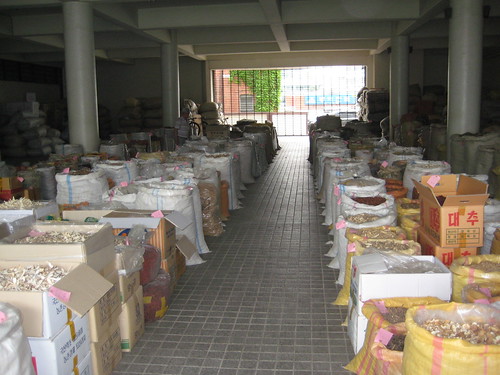
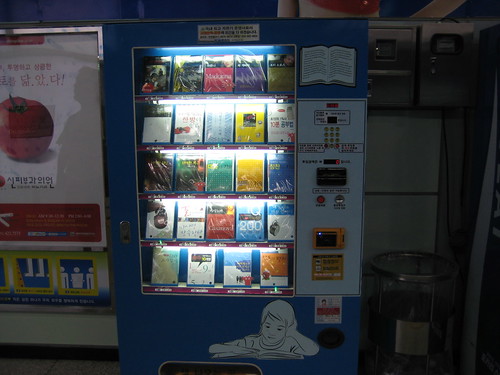 As we were leaving the bank, in what I'm quit sure was the same way we came in, we discovered that the entrance we had come in was now covered by a big gate. After looking around for a minute I noticed a side door leading to what looked like a closet that had a door to the street. The door was locked but being on the inside I could unlock it and we exited that way. I don't know whatever happened but if the bank managed to get itself robbed on account of an unlocked door it was their own fault. We had picked the town since it was known as some sort of traditional medicine hot spot and was supposed to have some big traditional medicine market. The market was pretty disappointing since it was just a bunch of stores not really an outdoor market. The best thing though was a big museum of traditional medicine and the crazy things it said. I've never really had much respect for traditional medicine and living in China has only made it worse with some of the nonsense the students spout off. If something really is good for you, like tea, then regular old science can prove that and not just rely on what someones grandma said. The museum had all sorts of wired display about the elements (earth, fire water, not sodium and beryllium) and nonsense about Qi but the best part was a computer which was supposed to find what sort of person you were and what things were good for you. Me and Ken both did it and despite entering very different things got the same result which included a list of things you should and should not eat. On my list was, I believe, oranges so know I know that orange juice doesn't agree with my Qi.
As we were leaving the bank, in what I'm quit sure was the same way we came in, we discovered that the entrance we had come in was now covered by a big gate. After looking around for a minute I noticed a side door leading to what looked like a closet that had a door to the street. The door was locked but being on the inside I could unlock it and we exited that way. I don't know whatever happened but if the bank managed to get itself robbed on account of an unlocked door it was their own fault. We had picked the town since it was known as some sort of traditional medicine hot spot and was supposed to have some big traditional medicine market. The market was pretty disappointing since it was just a bunch of stores not really an outdoor market. The best thing though was a big museum of traditional medicine and the crazy things it said. I've never really had much respect for traditional medicine and living in China has only made it worse with some of the nonsense the students spout off. If something really is good for you, like tea, then regular old science can prove that and not just rely on what someones grandma said. The museum had all sorts of wired display about the elements (earth, fire water, not sodium and beryllium) and nonsense about Qi but the best part was a computer which was supposed to find what sort of person you were and what things were good for you. Me and Ken both did it and despite entering very different things got the same result which included a list of things you should and should not eat. On my list was, I believe, oranges so know I know that orange juice doesn't agree with my Qi.